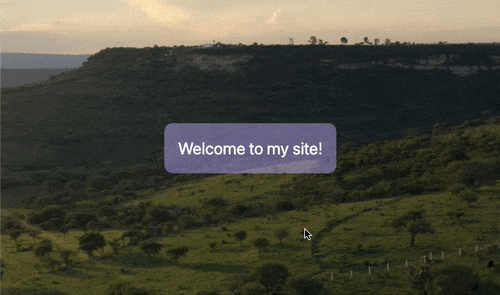Tailwind CSS full-screen video header
permalinkCall me old-school, but I love to see video headers. Hardly do I have a use for them on my personal website, but I love to implement a video header for clients with stunning videos.
In this tutorial I want to teach you how to implement a full-screen background video. We are only going to use the classes of Tailwind CSS.
The end result is this stunning full-screen video header using only Tailwind CSS:

Tailwind CSS full-screen video background permalink
To create this background, we are leveraging yesterday's Tailwind parallax header. It has a very similar setup, only now we don't make it parallax scroll.
The basic HTML structure will look like this:
<header>
<div>Welcome to my site!</div>
<video autoplay loop muted>
<source src="video.mp4" type="video/mp4" />
Your browser does not support the video tag.
</video>
</header>You can see we used an HTML header tag. In there, we have a div that will hold a block that will sit on top of the video. Then we have a video tag, which can hold a video or multiple sources.
I will now write down the end HTML structure and then go through the importance of each class.
<header class="relative flex items-center justify-center h-screen mb-12 overflow-hidden">
<div
class="relative z-30 p-5 text-2xl text-white bg-purple-300 bg-opacity-50 rounded-xl"
>
Welcome to my site!
</div>
<video
autoplay
loop
muted
class="absolute z-10 w-auto min-w-full min-h-full max-w-none"
>
<source
src="https://assets.mixkit.co/videos/preview/mixkit-set-of-plateaus-seen-from-the-heights-in-a-sunset-26070-large.mp4"
type="video/mp4"
/>
Your browser does not support the video tag.
</video>
</header>The classes used for the video background:
relative: Makes the header element relative. We will make the video absolute to position it.flex: Adds a display flex so we can align the text block insideitems-center: Aligns the text-block verticallyjustify-center: Aligns the text-block horizontallyh-screen: The h-screen adds a 100vh height, so the video is scaled to 100% of the viewport height.mb-12: We add quite a big margin-bottom with this (3rem)overflow-hidden: The video will be slightly bigger than our header, so we don't want to show the overflow.
Then for our overlay text block, we use the following classes:
relative: We need to make this relative, to place it on top of the videoz-30: This needs to be higher than the z-index on the videop-5: Adds equal padding on each side (1.25rem)text-2xl: Makes the text nice and big (1.5rem)text-white: Make the text whitebg-purple-300: A nice cool purple colorbg-opacity-50: This one makes sure the background has an opacity of 50%.rounded-xl: Adds the nice rounder borders
And last but not least, we can add the classes for our video element:
absolute: The video is an absolute positioned elementz-10: We give the video a lower z-index than our text-block to keep it in the backgroundw-auto: The width can be auto, so it will adjustmin-w-full: We need to make the min-width 100%min-h-full: The same goes for the min-heightmax-w-none: Unset the default max-width
With this, we have all our classes in place. This will give us a very nice full-screen video header using only Tailwind CSS classes.
See the code example in this Codepen permalink
See the Pen Tailwind CSS video header by Chris Bongers (@rebelchris) on CodePen.
Thank you for reading, and let's connect! permalink
Thank you for reading my blog. Feel free to subscribe to my email newsletter and connect on Facebook or Twitter